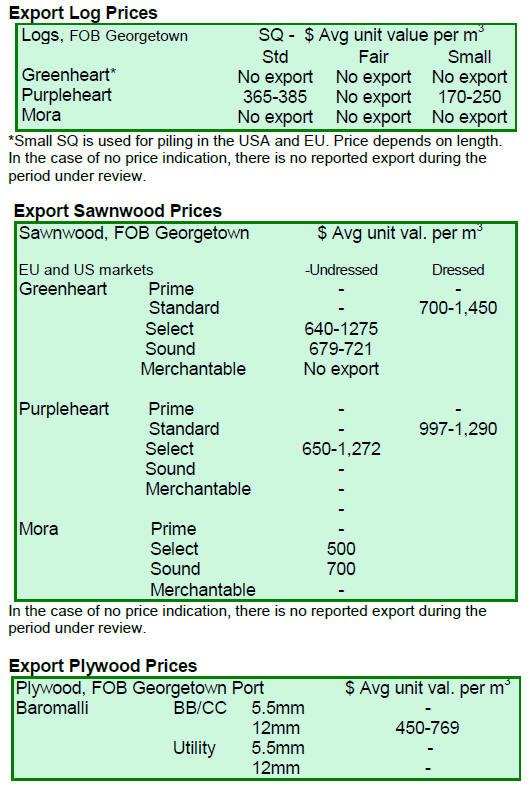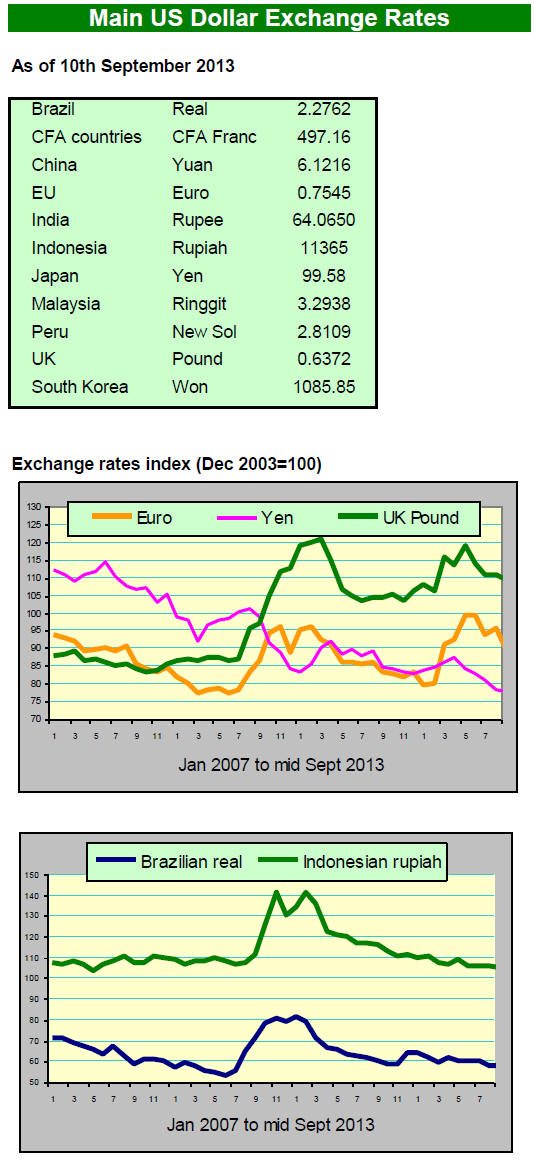2. GHANA
Woodworkers Association fears VPA means
job losses
Members of the Takoradi Wood Workers Association are
concerned that there may be job losses when the VPA is
implemented in 2014 even though its supporters claim it
will provide new market opportunities. The Ghana
Forestry Commission is now working to allay the fears of
association members saying they appear to have
misconstrued the concept of the VPA.
At a stakeholders meeting in Takoradi, the Trade and
Industry Manager at the Timber Industry Development
Division (TIDD), Mr. Peter Zormelo, explained the VPA
is to improve transparency and accountability by ensuring
that timber products exported to the EU from Ghana have
been legally acquired, harvested, transported and shipped
in compliance with local laws.
He advised association members to ensure they register
their operations in order to acquire vendor licences to do
legitimise their businesses.
To protect members from possible loses that might be
associated with the VPA implementation the National
Secretary of the Domestic Lumber Trade Association of
Ghana (DOLTA), Mr. Afreh Boakye, suggested there is a
need for the GFC to ensure a regular supply of legal
timber to the local market from established sawmills and
artisan millers.
New team of specialised prosecutors for forest
offenders
The GFC and the Attorney General‟s Department has
provided specialist training on forest and wildlife laws to
more than 25 public prosecutors so quick and tough legal
action can be taken on those breaking the country‟s forest
and wildlife laws.
The trainees were taken through 8-weeks of intensive
training in criminal law and procedure, introduction to the
Forestry/Wildlife laws common offences and courtroom
procedures.
The mandate granted the new prosecutors by the Ministry
of Justice and Attorney General forms part of measures to
combat illegal exploitation of forest and wildlife
resources.
At the trainees passing out ceremony the Chief Justice,
Mrs. Justice Georgina Wood, commended the Forestry
Commission for this bold initiative and said the move was
necessary to protect the environment and save the country
huge financial loses.
The Minister of Lands and Natural Resources, Mr. Alhaji
Inusah Fuseini, said the successful training of specialised
prosecutors was timely to arrest the threat to the
sustainability of the country‟s forest and wildlife
resources.


¡¡
3. MALAYSIA
Reduced fuel subsidy will push up
production costs
The Malaysian government has announced a reduction in
fuel subsidies. From 2 September the subsidy will be
reduced by 20 sen a litre on the most popular grade of
petrol (RON 95) which, say analysts, will push up prices
by around 10.5%.
Subsidies on diesel will also be reduced by 20 to 80 sen a
litre which is expected to push up industry transport costs.
Most analysts in Malaysia say that the increase in fuel
prices could push inflation up to 2.2% for the year from
the projected 2.0%.
The Malaysian government has justified the change on the
grounds that it needs to rationalise subsidies and that
failure to do so could push the country into financial
difficulties.
Researchers at AmResearch said ¡°in 2013 the government
has set aside a staggering RM24.8 billion or approximately
11.9% of total revenue to fuel subsidies¡±. At current
exchange rate, this works out to roughly US$7.5 billion for
2013. The budget deficit was 4.5% of the country‟s Gross
Domestic product (GDP) last year.
Malaysia‟s high budget deficit was cited as one of the
reasons why last year the international rating agency,
Fitch, lowered Malaysia‟s rating to negative from stable.
While most Malaysians understand the need to cut
subsidies for better fiscal management they are also
bracing themselves for a series of price hikes ranging from
transportation to food costs.
Making matters worse for consumers is the weakening
ringgit against the US dollar (as much as 9% in the last
two months) making imports more expensive.
Industry analysts suggested the changes will result in
higher logging and production costs in the timber industry
but it is too early to foresee if the increase can be absorbed
or whether they will try and pass on the extra cost to
buyers.
Speedier export license issuance with new online
system
The Sarawak Timber Industry Development Corporation
(STIDC) has launched an improved version of its online
licensing system in an effort improve the efficiency in
issuance of export and import licenses.
At the ceremony launching the new online system, Awang
Tengah Ali Hasan, Minister of Resource Planning and
Environment, said that exports for the first half of 2013
dropped by 2.7% compared to the same period last year.
He further said, ¡°Sarawak recorded exports worth RM.606
billion (approximately US$ 1.1 billion) in the first six
months of this year as compared to RM.705 billion last
year¡±.
Sarawak exported RM 7.5 billion worth of timber products
last year (approximately US$ 2.27 billion).
The drop in export value for this year was attributed to the
economic slowdown in importing countries, particularly in
the Middle East where political uncertainties lowered the
demand for timber.
Major buyers for Sarawak timbers remain as Japan, South
Korea, India, China, Thailand and the Philippines.
Market preferences clearly reflected in average export
prices
The Sabah Department of Statistics has released
sawnwood export data showing that exports from January
to July 2013 were 149 157 cu.m worth RM 217 mil.
(approximately US$ 65.74 million).
The main importer was Thailand taking almost 25%
(37,329 cu.m). China was the second largest importer
accounting for 22,501 cu.m of sawnwood exports. The
third ranked importer was Taiwan P.o.C where January to
July exports totaled 18,866 cu.m worth RM24.0 million.
Average prices in the different markets vary and reflect
preferences for species and grades. In Thailand the
average price was RM1,228 per cu.m, China RM1,484 per
cu.m and Taiwan P.o.C RM1,270 per cu.m.
In contrast, sawnwood exports to Belgium at 3,256 cu.m
were at an average price of RM2,249 per cu.m while the
average price of sawnwood exports to the UK was
RM2,556 per cu.m.
The comparable figure for Netherlands sawnwood imports
was RM2,822 per cu.m indicating that European importers
are buying higher grades.
In the first seven months, Sabah‟s exports of sawnwood
were mainly of two species groups: dark and light red
meranti, meranti bakau (29.6%) and keruing, ramin, kapur,
teak, jelutong, kempas, mengkulang, balau (29.6%).
The data revealed the most expensive sawnwood exported
was kayu malam at an average price of RM3, 346 per cu.m
or about US$ 1,014 per cu.m.
4. INDONESIA
EU report on import procedures for FLEGT-licensed
timber
The EU FLEGT newsletter says that a report on the testing
of export and import procedures for Indonesia‟s timber
and timber products is now available.
The report is titled „V-Legal/FLEGT shipment test ¨C
Lessons learned from the EU visits‟ this and related
documents can be downloaded from:
http://www.euflegt.efi.int/portal/newsletter/
Indonesia and the EU organised a trial shipment of SVLK
certified timber to identify issues hindering the efficient
processing of export and import documents and the future
flow of FLEGT-licensed timber products to EU member
states.
The authors of the report note several significant findings
and the EU FLEGT newsletter provides an example
saying: ¡°for example, a ship will often change
destinations en route or a shipment will change ownership
while at sea.
When this happens, some information in the FLEGT
license no longer matches the actual shipment, which
could lead to delays in customs clearance¡±.
Rampant inflation and falling rupiah hits consumers
Indonesia is gripped by surging in inflation which is now
at its highest level the global financial crisis in 2009.
Adding to the woes of consumers is the weakening rupiah
which had fallen to a low of 11,365 (around -14%) against
the US dollar by mid September.
The combined effect of an outflow of foreign capital
because of uncertain domestic growth prospects and the
inevitable slowing of the US domestic economic stimulus
programme has focused attention on Indonesia‟s
expanding trade deficit.
Expansion of trade finance key to market
diversification
The Indonesian ministry of finance has announced plans to
expand the trade financing scheme to encourage more
exporters to adventure into new markets.
The ministry recognizes that there are risks when
developing markets outside the traditional ones of the US,
EU and China so is seeking ways to support exporters.
An expanded trade financing scheme addressing up-front
finance and insurance for exporters could go a long way to
facilitate market diversification said Finance Minister
Chatib Basri.
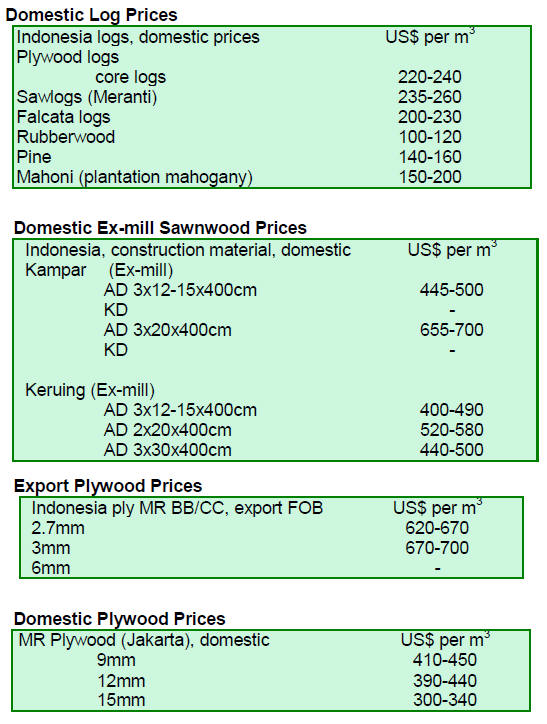

¡¡
5. MYANMAR
Plunge in rupee exchange rate puts brake
on trade
Most buyers say the market for teak logs is weak and
almost at a standstill for the non-teak hardwood logs.
Myanmar‟s largest timber buyer, India, is beset by
economic problems and the volatile rupee exchange rate is
disrupting normal trade.
However, some analysts expect the rupee exchange rate to
stabilise and then appreciate again getting back to a rate of
60-61 rupee to the US dollar by year end.
Despite the exchange rate constraints the Myanma Timber
Enterprise (MTE) has issued a circular urging buyers to
promptly pay for and ship logs ready for despatch from
Yangon.
Teak and other hardwood log exports down
A comparison of shipment statistics show that from April
to August this year only 161,050 cubic metres of teak logs
were shipped compared to 208,500 cubic metres for the
same period last year.
Non-teak hardwood log shipments for the five months in
fiscal 2013/14 were 580,000 cubic metres in contrast to
the 650,300 cubic metres last year.
Flow of off-shore financing for loggers uncertain
With the onset of the rain season in Myanmar log
harvesting begins in earnest but some observers are of the
opinion that logging companies will proceed cautiously as
their usual off shore financing and commitments from
buyers may not be forthcoming.
This could mean that only the top quality logs will be
extracted and the lower grades left behind and that harvest
levels will be lower than planned.
To avoid logs being abandoned in the forest the Forest
Department and MTE will be closely supervising logging
operations,
UK trade magazine welcomes reorganisation of MTE
The UK Trade Times Journal (TTJ) recently commented
on the issue of corporatisation of MTE and it was
mentioned that this would require legislation, physical and
financial restructuring could involve staff retrenchment.
The author of the article in the TTJ said that it would be a
huge task for the MTE to adapt to the challenging times.
Myanmar¡¯s overland exports top US$1.9 billion in
just
five months
The Irrawaddy News Magazine has reported that
Myanmar‟s border trade stood at US$1.9 billion in the first
five months of fiscal 2013-14, a rise of US$391 million
over the same period last year.
Myanmar‟s exports to China, Thailand, Bangladesh and
India hit US$1.17 billion from April to August, compared
to US$710 million in imports according to the Xinhua
News Agency.
Teak tender prices
The following prices were recorded for teak log sales
during competitive bidding on 23rd and 26th August
during the MTE tender. The next sale will be held in late
September.

6.
INDIA
GDP growth battered
GDP growth in India has fallen to a four-year low. A
growth rate of 4.4% for the April-June 2013 quarter
indicates a sharp slowdown from the 5.4% GDP growth in
the same period last year and is below the 4.8% growth
achieved in the January-March 2013 period.
The weakened rupee has pushed up import costs and the
impact of higher oil prices and continued uncontrolled
imports of gold are beginning to bite. Adding to the deficit
problem are restrictions on mining because of
environmental concerns and because of objections from
people living in the mining areas. These restrictions have
lowered output and exports.
By the end of August the rupee had fallen about 16%
against the USD dollar driving up the cost of imports and
widening India's massive current account deficit. By early
September the slide of the rupee was arrested as the new
Reserve Bank of India governor took office but for how
long the exchange rate will hold is difficult to predict.
Volatile rupee drives up industry production costs
The volatility of the rupee became such a concern to
industry that in late August the Kerala Plywood
Manufacturers Association called a meeting to discuss the
risks to industry from the rapidly depreciating rupee.
A severe shortage of domestic logs has caused prices to
rise sharply and imported logs are becoming more
expensive. In addition, the cost of imported core and face
veneers and resins are rising. When added to rising labour
costs the increase in electricity tariffs and higher
transportation costs due to rising fuel plywood
manufacturers had little choice but the raise prices to
remain viable.
A rise of 15% in prices of all plywood products went into
effect on 1 September and mills in northern India and
other parts of the country have followed suit.
Kerala plymills depend on multiple sources for logs
Plywood manufacturers in Kerala depend on rubberwood
(from plantations which are being replaced), silver oak
logs and other domestic hardwoods to feed their mills.
When domestic sources are insufficient mills use imported
eucalyptus veneers from Vietnam.
Plywood mills in northern India depend mainly on locally
grown poplar and eucalyptus logs and supplement supplies
with gurjan from Myanmar and keruing and other peeler
logs from Sarawak. It is interesting to note that the panel
industry imports eucalyptus logs from as far away as
Uruguay.
Paper industry raises prices in face of escalating
production costs
Rising input costs are eating in the margins of paper
industry and producers in India have announced price
increases of between 5-8% for many products.
Industry observers say domestic log raw material costs for
the pulp industry have increased 10-15%, adding that
imported pulp has also become more expensive because of
the depreciation of the rupee.
Overseas Indians taking advantage of exchange rate to
invest in property
The impact of the current economic crisis in the country is
now being felt by the construction industry as demand for
new homes has evaporated and some now talk of a glut of
houses and sliding property prices.
While this is a tough time for builders and real estate
companies, buyers can secure a bargain and there are
indications that non-resident Indians are taking advantage
of the exchange rate to transfer US dollars to India and
investing in property.
Prices for imported plantation teak
Fluctuations in Indian rupee continue to plague plantation
timber importers. When the rupee fell below Rs60 to the
US dollar importers were finding the landed costs were too
high and could not be passed on to domestic consumers.
Because of the uncertain exchange rate the teak import
business has virtually come to a halt as domestic endusers
cannot accept the higher prices. Analysts say some
companies cancelled orders but that there are still
shipments in the pipeline.
Current C & F prices, Indian ports per cubic metre
are
shown below.

Ex-mill prices for sawnwood
Domestic ex-sawmill prices for air dried sawnwood cut
from imported logs. Prices per cubic foot are shown
below.

Domestic prices for Myanmar teak processed in
India
The effects of higher log landed costs are now reflected in
prices being quoted for Myanmar logs sawn by Indian
mills.
Current prices are shown below.

Prices for imported sawnwood
Ex-warehouse prices for imported kiln dry (12% mc.)
sawnwood per cu.ft are shown below.

Plywood prices
Prices for imported logs and veneers are rising but
fortunately supplies of domestically grown eucalyptus and
poplar have improved because of investment in plantations
in northern India.
Under the present conditions mills have to revise prices
more often than in the past which is making it difficult for
endusers such as builders and construction companies to
plan ahead.
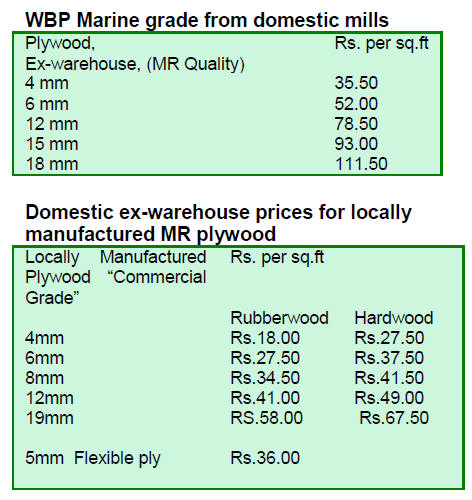
7.
BRAZIL
Forest Service recommends tax breaks
for industry
A study prepared by the Brazilian Forest Service (SFB)
has found that the tax burden levied on timber products in
the Amazon region is 32% along the entire value chain
from harvesting to final consumer.
The authors propose reconsideration of the tax levels and
even some exemptions to strengthen the Amazon region
forest economy and increase the competitiveness of
tropical timber products.
There are proposals for exemption of the tax on
Contribution to the Social Integration Program and Civil
Service Asset Formation Program (PIS/PASEP), the tax
on Contribution for Social Security Financing (COFINS)
and the tax on Industrialized Products (IPI).
According to SFB, the entire production chain for
Amazonian timber generates some R$7 billion, of which it
is estimated R$2 billion is paid in taxes.
The exemption proposals will involve a loss of revenue for
the government, for example the tax on circulation of
goods and services (ICMS), estimated loss R$ 40 million.
The COFINS tax loss would be R$19 million and the IPI
tax loss would be an estimated R$28 million.
The SFB study says the tax reductions will result in
increased competitiveness of tropical wood products.
IBAMA operation results in huge fines on operators
In August this year IBAMA started operation "Hil¨¦ia
Patria" in Buriticupu, Eastern Amazon, he aim of which is
to combat trade in illegal timber.
In less than a month more than 4,000 cubic metres of
illegally harvested timber was seized in indigenous
reservation areas in the Western region of Maranhão state.
The amount of wood seized in the operation is said to be
equivalent to 110 truck loads. Fines amounting to R$2.3
million were levied on those handling and transporting the
illegal timber and equipment was seized.
IBAMA conducted the August operation in several
municipalities in the indigenous reserves of Auto Turiaçu,
Aw¨¢ and Caru.
In Buriticupu municipality 95 sawmills are registered by
the federal environmental agency but in fact only 25
sawmills were operational of which 22 sawmills had
inadequate administrative procedures involving such
issues as, timber of unknown legal origin, invalid or
expired operating licenses.
Furniture industry seeks to expand Middle East market
opportunities
Some furniture manufacturers in Paran¨¢ state have been
exporting to Egypt since 2007 and this year started to
export to the United Arab Emirates (UAE), Oman and
Algeria. The companies in Brazil are aiming to expand
exports to other countries in the Middle East and will try
to find new markets through participation in the „Index
Dubai‟, one of the largest international furniture
exhibitions.
Furniture sales to UAE started after participation by
furniture manufacturers in the Movelpar Fair in Paran¨¢
state held in March 2013.
A furniture company located in Arapongas municipality,
one of the largest centres for furniture production in
Paran¨¢ State, produces around 36,000 pieces of furniture
per month and generates around 12% of its turnover from
exports.
This company sells to about 20 countries, including Chile,
Peru, Paraguay, Uruguay, France, French Guyana,
Namibia, Angola, South Africa, and Mozambique. Chile
and Peru are the largest markets. The products for export
are wide-ranging, such as home theater, racks, shelves,
countertops, and other furniture for living room and home
office.
Brazil, the exciting emerging consumer market
¡°After a remarkable decade of steady growth and
economic stability, Brazil has emerged as one of the
world‟s most important new consumer markets¡± says a
new report from The Boston Consulting Group‟s Center
for Consumer and Customer Insight.
See:
https://www.bcgperspectives.com/content/articles/center_c
onsumer_customer_insight_globalization_redefining_braz
ils_emerging_middle_class/
The report continues; ¡°Millions of families that not long
ago struggled for subsistence can now afford such basics
as kitchen appliances and mobile phone service. Millions
more now earn enough to pay for private school and a
second car. And in the years ahead, the ranks of such
consumers will swell enormously. By 2020, Brazilian
households will represent an annual market of around $1.6
trillion (3.2 trillion Brazilian real).
The Boston Consulting Group report says, ¡°While the
decade from 2000 to 2010 in Brazil was marked by the
ascent of millions of households out of poverty, the
current decade will be characterised by a massive shift into
the ranks of the middle class and affluent.
Some 5.3 million households will rise from the restricted
to the emergent middle-class segment. An additional 1.6
million and 1.9 million will enjoy established middle-class
and affluent lifestyles, respectively.
Families in the emergent, established, and affluent
segments will make up 37 percent of Brazilian households
by 2020, compared with 29 percent in 2010 and just 24
percent in 2000. These households will account for more
than 85 percent of incremental spending from 2010 to
2020¡±.
The report goes on to suggest strategies that
companies
could take to gain a foothold in the Brazilian market.
Domestic and export price movements
In US dollar terms many prices fell over the past weeks
dropping an average of around 8% due to exchange rate
movements.

8. PERU
Good news on Chinese economy a boost
new sol
The national currency the new sol strengthened recently
buoyed by the turn-around in the Chinese economy. China
is the biggest market for commodities from Peru. The new
sol exchange rate against the US dollar was 2.7970 on 11
September the highest level for months.
The strong performance of the Chinese economy and
action by the central bank to support the new sol
encouraged buyers to snap up the new sol.
Around 700 thousand hectares are certified in Peru
There are said to be 547,450 hectares of FSC certified
forests in Peru distributed over eight companies and two
forest communities. Six of the certified forest is in Madre
de Dios. Others are Ucayali and Loreto, the native
community of Puerto Esperanza in Ucayali and Belgium
in Madre de Dios.
Legal action taken over deforestation
A company in the Yurimaguas district, Alto Amazonas,
Loreto faces prosecution over alleged clearing of 500
hectares of forest to expand its production of palm oil used
as biofuel.
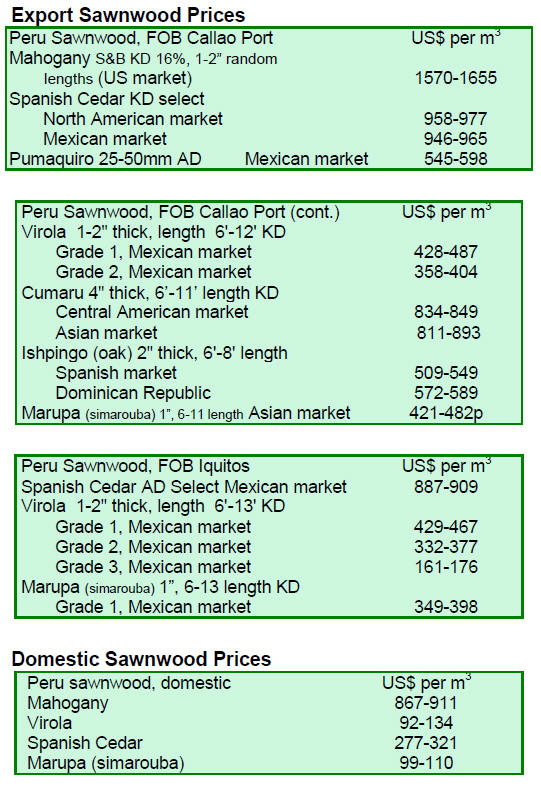
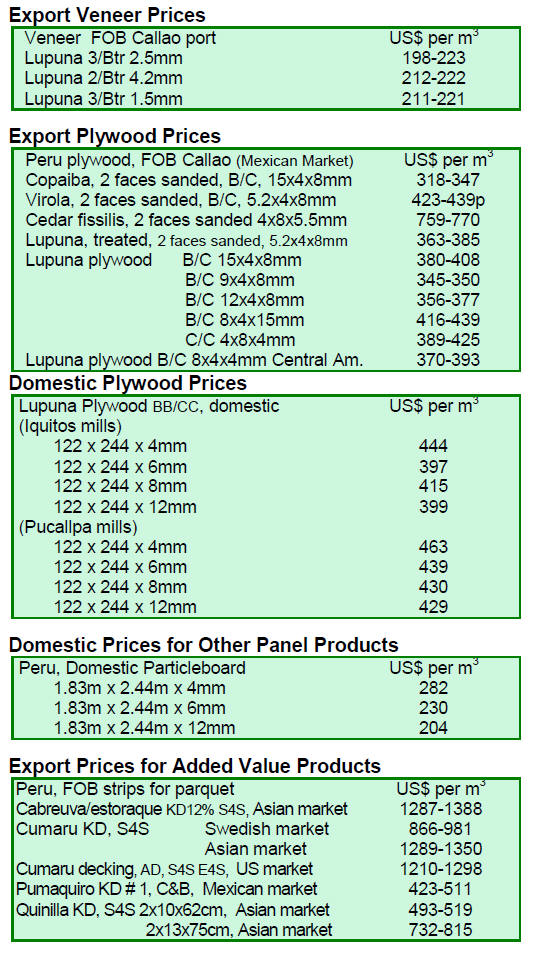
9.
GUYANA
Firm demand for purpleheart lifts prices
During the period reviewed only purpleheart logs were
exported and prices secured were significantly higher for
all categories.
Standard sawmill quality purpleheart logs attracted prices
as high as US$385 per cubic metre FOB, Fair quality logs
were traded at US$300 per cubic metre FOB while Small
quality purpleheart logs were priced at US$250 per cubic
metre FOB.
Some other lesser used species were traded in log form
and these timbers attracted favourable prices in Asian
markets.
Exporter¡¯s confidence returns as demand firms for
sawnwood
Sawnwood exports were positive and favourable prices
were secured in all markets, signalling some improvement
in demand.
Undressed sawn greenheart prices for Select qualities
attracted top end prices of around US$1,275 per cubic
metre FOB, while Merchantable qualities were traded at as
much as US$721 per cubic metre FOB.
The major markets for Undressed greenheart include Asia,
Caribbean, Europe and North America.
Undressed purpleheart sawnwood exports were only of
Select quality and top end prices were US$1,272 per cubic
metre FOB. Caribbean countries such as Trinidad and
Barbados are the main markets for this popular category of
sawnwood.
Undressed mora sawnwood secured fair prices on the
export market with Select quality timber earning US$500
per cubic metre FOB. Sound category mora sawnwood
achieved prices of US$700 per cubic metre FOB and the
main markets for this commercial timber were Asia and
Europe.
Dressed greenheart sawnwood prices remained firm
during the period reviewed holding steady at US$1,450
per cubic metre FOB in the Caribbean market.
In contrast, dressed purpleheart sawnwood export prices
climbed from US$1,124 to US$1,290 per cubic metre
FOB. This species and quality is popular in the Caribbean
and European markets.
Hububalli products feature in added value export sales
Value added products featured in recent export sales with
products such as doors and indoor furniture utilising
Guyana‟s hububalli (Loxopterygium sagotii) proving
popular in the Caribbean and regional markets.
Splitwood (wallaba shingles) earned attractive prices of
US$1,099 per cubic metre FOB in Caribbean markets.
Guyana plywood prices improved in the period reviewed
with top end prices moving from US$615 to US$769 per
cubic metre FOB. The main export markets for Guyana
plywood are the Caribbean and other regional markets.
Regioan meeting urged to provide new input to FAO¡¯s
regional programme
In mid September Guyana hosted the 28th Session of the
Latin American and Caribbean Forestry Commission.
Addressing the gathering the FAO representative in
Guyana, Dr. Lystra Fletcher-Paul urged the participants to
suggest how the FAO work programme in the region can
best be structured to respond to regional priorities.
Governance and sustainable were the main issues
discussed along with measures to address illegal logging.
Guyana has benefited significantly from UN support in
capacity building within the forestry sector to meet
international forestry requirements.
